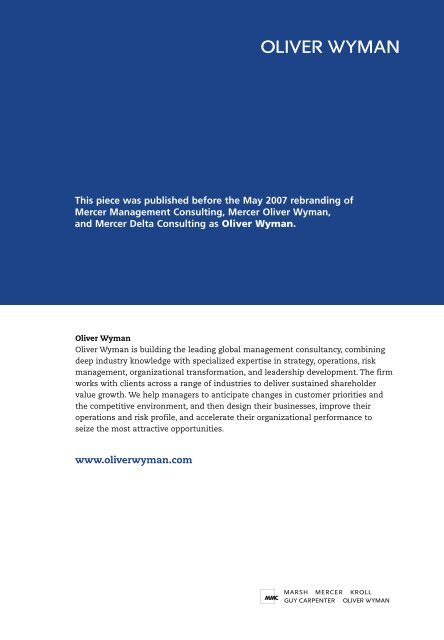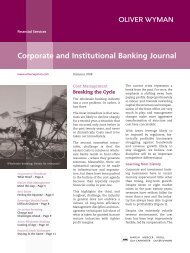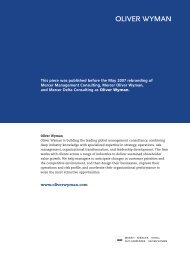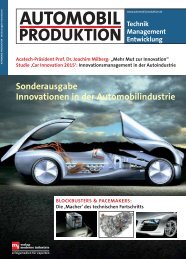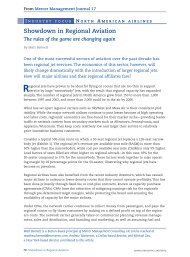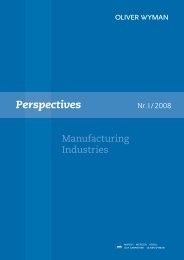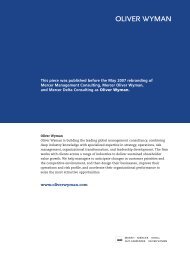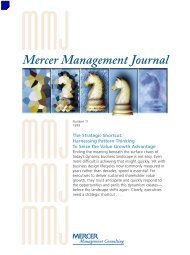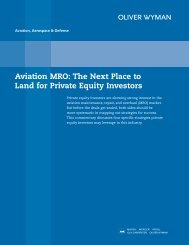Internationalizing for European Rail Freight Growth - Oliver Wyman
Internationalizing for European Rail Freight Growth - Oliver Wyman
Internationalizing for European Rail Freight Growth - Oliver Wyman
You also want an ePaper? Increase the reach of your titles
YUMPU automatically turns print PDFs into web optimized ePapers that Google loves.
This piece was published be<strong>for</strong>e the May 2007 rebranding of<br />
Mercer Management Consulting, Mercer <strong>Oliver</strong> <strong>Wyman</strong>,<br />
and Mercer Delta Consulting as <strong>Oliver</strong> <strong>Wyman</strong>.<br />
<strong>Oliver</strong> <strong>Wyman</strong><br />
<strong>Oliver</strong> <strong>Wyman</strong> is building the leading global management consultancy, combining<br />
deep industry knowledge with specialized expertise in strategy, operations, risk<br />
management, organizational trans<strong>for</strong>mation, and leadership development. The firm<br />
works with clients across a range of industries to deliver sustained shareholder<br />
value growth. We help managers to anticipate changes in customer priorities and<br />
the competitive environment, and then design their businesses, improve their<br />
operations and risk profile, and accelerate their organizational per<strong>for</strong>mance to<br />
seize the most attractive opportunities.<br />
www.oliverwyman.com
600<br />
500<br />
400<br />
300<br />
200<br />
100<br />
0<br />
<strong>Internationalizing</strong> <strong>for</strong> <strong>European</strong> <strong>Rail</strong><br />
<strong>Freight</strong> <strong>Growth</strong><br />
By Joris D’Incà and Urs Mosimann<br />
It is fairly well known that <strong>European</strong> freight railroads have had a tough time<br />
competing against other modes <strong>for</strong> many decades, with a resulting slow decline<br />
in freight modal share. The good news is that this decline seems to have been<br />
arrested: rail freight’s overall modal share versus road and inland waterways is<br />
expected to remain around 16 percent over the near term, while the total rail<br />
freight market will grow by a slow but steady 2 percent per year through 2015<br />
(Exhibit 1).<br />
Exhibit 1 <strong>Rail</strong> <strong>Freight</strong> Transport <strong>Growth</strong> in Europe, 1980-2015<br />
(billion metric ton-kilometers, rail share in % 1 )<br />
570<br />
26.0%<br />
473<br />
368<br />
19.0% 19.0%<br />
1980 1990 1995 2000 2005E 2010E<br />
Percentage share of rail in total freight transport 1<br />
New EU countries (CAGR 2005-2015: +1.3%)<br />
EU15+Norway & Switzerland (CAGR 2005-2015: +2.2%)<br />
1 <strong>Rail</strong> share of road, rail, and inland shipping, excludes pipelines, air freight, and sea freight.<br />
Source: 1980-1990 EU Directorate-General Energy and Transport, 1995-2015E: ProgTrans, Mercer analysis.<br />
This stable market belies a competitive landscape that will change dramatically<br />
over the next 10 years, the result of increasing demand <strong>for</strong> “international,” i.e.,<br />
cross-border, rail freight service (particularly intermodal), the continuing entry of<br />
new operators, and shippers more willing and able to switch to the provider that<br />
offers the best service at the lowest price. In this environment, both incumbent<br />
railroads and new operators will be challenged to keep margins from eroding.<br />
As discussed herein, Mercer believes that strategies focused on maximizing<br />
productivity and internationalizing rail freight service as the ones most likely<br />
to prevail.<br />
New <strong>Rail</strong> <strong>Freight</strong> Traffic Patterns<br />
<strong>European</strong> railroads today move approximately 400 billion metric ton-kilometers<br />
of freight with a market value of €19 billion (US$24.4 billion). Where once rail<br />
freight was largely domestic (that is, within one country’s borders), today<br />
14 Mercer on Transport & Logistics<br />
386<br />
17.0%<br />
400<br />
15.8%<br />
440<br />
15.3%<br />
485<br />
15.4%<br />
2015E<br />
35%<br />
30%<br />
25%<br />
20%<br />
15%<br />
10%<br />
5%<br />
0%
44 percent of traffic moves cross-border within continental Europe. Most of the<br />
anticipated growth in rail freight will be <strong>for</strong> traffic moving more than 500<br />
kilometers (300 miles), thus driving up international market share. Intermodal<br />
represents the fastest growing <strong>for</strong>m of this traffic, with an average annual<br />
growth rate of 6-7 percent, due to ongoing trade globalization and<br />
containerization trends. Thus growth in <strong>European</strong> rail freight will be driven to a<br />
large extent by demand <strong>for</strong> containerized finished and semi-finished goods.<br />
At the same time, traditional short haul rail volumes likely will continue to<br />
decline. Only goods that play to the strengths of rail are likely to remain captive<br />
(e.g., bulk goods such as coal and grain, and hazardous freight). Concentration of<br />
traffic flows on a few major corridors is unlikely to change in the near term,<br />
with the main international transport flows moving along a north-south axis,<br />
particularly between the North Sea and Italy (Exhibit 2). Even though transport<br />
flows on the east-west axis are growing rapidly, they will represent only a<br />
fraction of total volumes moving north-south <strong>for</strong> the <strong>for</strong>eseeable future.<br />
Exhibit 2 Top 10 <strong>European</strong> Cross-Border Transport Flows<br />
Top 10 Totals<br />
(billion metric<br />
ton-kilometers)<br />
North-South: 18.5<br />
East-West: 7.4<br />
Source: Eurostat, national statistics, Mercer analysis.<br />
The Changing Competitive Landscape<br />
Despite ongoing liberalization, the <strong>European</strong> freight rail market continues to be<br />
dominated by incumbent railroads. Some countries have issued rail freight<br />
operating licenses to new entrants, but only in a very few have market shares of<br />
traditional rail freight providers dropped below 90 percent (Exhibit 3).<br />
But these incumbents are facing more pressure than ever be<strong>for</strong>e to improve<br />
their competitiveness. Shippers represent one source of pressure: they are<br />
dissatisfied with the slow progress of liberalization, and consequently the<br />
mediocre quality and high price levels of current rail freight services. A recent<br />
Mercer survey found that they are increasingly ready to switch providers if more<br />
15 Mercer on Transport & Logistics<br />
Norway<br />
Netherlands<br />
2 5<br />
Poland<br />
Belgium<br />
France<br />
6<br />
Germany<br />
3<br />
10 7<br />
9<br />
Czech<br />
Republic<br />
8 1<br />
Austria<br />
Switzerland<br />
4<br />
Italy<br />
Sweden
eliable and faster service, and lower prices can be had elsewhere (Exhibit 4).<br />
Some large shippers have even created their own railroads to bring more<br />
competitiveness to the market. <strong>Rail</strong>4chem, <strong>for</strong> example, is operated as a joint<br />
venture by the German chemical company BASF, the car leasing company VTG,<br />
and the chemicals logistics companies Bertschi (Switzerland) and Hoyer<br />
(Germany).<br />
Exhibit 3 Incumbent <strong>Rail</strong>road <strong>Freight</strong> Share in Europe<br />
Country<br />
Finland, France, Greece, Ireland,<br />
Luxembourg, Norway, Portugal<br />
Austria, Czech Republic, Italy, Poland<br />
Belgium, Denmark, Spain<br />
Germany, Hungary<br />
Sweden<br />
Netherlands, Switzerland<br />
Source: Erail Report (June 2004), Competition Report DB AG 2005, <strong>Rail</strong> Liberalization Index 2004,<br />
IBM/Prof. Kirchner, UIC, annual reports, interviews.<br />
New entrants represent another major source of pressure. As could be expected,<br />
most new freight operators utilize a “cherry picking” strategy, targeting the most<br />
attractive long-distance traffic and regular block trains. As a consequence, prices<br />
<strong>for</strong> regular block train traffic (bulk and intermodal traffic) have come under<br />
stress and are expected to decline by an average 2 percent per year over the<br />
near term.<br />
The stress on prices, combined with continuously increasing costs <strong>for</strong><br />
infrastructure access, energy, and rolling stock (due to growing technological<br />
requirements, e.g., ETCS or multi-current-traction systems) is creating a<br />
situation in which, Mercer estimates, railroads must improve their productivity<br />
at an average rate of 3-4 percent every year to keep margins from eroding. US<br />
Class I railroads faced a similar experience in the two decades after deregulation<br />
in 1980, achieving stable margins in the face of a constant need to reduce rates<br />
only through continual productivity improvements, such as widespread<br />
rationalization of networks and assets.<br />
A Drastically Different Future?<br />
The incumbent <strong>European</strong> railroads are unlikely to achieve needed productivity<br />
gains on a sustainable, long-term basis using current responses—which mainly<br />
have been to selectively optimize only parts of the business—or to achieve<br />
significant growth based on generalist business designs that try to be all things<br />
to all customers. A new focus on ways to increase productivity will be<br />
16 Mercer on Transport & Logistics<br />
Market Share of Largest<br />
<strong>Rail</strong> <strong>Freight</strong> Transport Provider<br />
100%<br />
~97-98%<br />
~95-96%<br />
~85%<br />
~80-90%<br />
~80%<br />
Increasing<br />
competitiveness
Exhibit 4 Requirements <strong>for</strong> Switching <strong>Freight</strong> <strong>Rail</strong> Providers:<br />
The Customer’s Perspective<br />
100%<br />
80%<br />
60%<br />
40%<br />
20%<br />
0%<br />
<strong>Rail</strong> costs are costs that result from<br />
poor quality. Costs are incurred by<br />
alternative solutions in emergencies<br />
More reliable<br />
deliveries<br />
Better<br />
prices<br />
Source: Mercer <strong>Freight</strong> Forwarder Survey 2005.<br />
imperative, such as unbundling and outsourcing parts of the value chain to third<br />
parties. Additionally, clear-cut business models that are in line with the<br />
increasingly international nature of <strong>European</strong> rail freight will be necessary to<br />
capitalize on the opportunities that expanding liberalization will provide.<br />
Mercer recently developed an assessment of competitive scenarios <strong>for</strong> <strong>European</strong><br />
rail freight in 2015. Our expectation is that within 10 years, the international<br />
<strong>European</strong> rail freight market will likely be focused around five business designs,<br />
as shown in Exhibit 5. A maximum of three large pan-<strong>European</strong> network<br />
providers will prevail, in competition with various specialist operators (such as<br />
low-cost providers on selected corridors, intermodal operators, and specialists<br />
offering rail logistics solutions <strong>for</strong> selected industries such as chemicals and<br />
automotive). These entities will shape the future competitive landscape and will<br />
cooperate with regional trainload feeder networks, local production/services<br />
providers, and rail supply firms providing rolling stock leasing and maintenance.<br />
A Dual Strategy <strong>for</strong> Incumbents<br />
To survive in this new competitive landscape, incumbents will need to pursue a<br />
dual strategy: rightsizing capacity and restructuring the domestic core business<br />
on the one hand, and focusing on internationalization—the only real<br />
opportunity <strong>for</strong> growth—on the other.<br />
Sustainable restructuring of the domestic core business will require a number of<br />
levers to be pulled, including:<br />
� Developing a clear structure <strong>for</strong> the railroad’s product offerings<br />
17 Mercer on Transport & Logistics<br />
Aggressive pricing: negotiations only<br />
begin to make sense when savings<br />
of 8-20% can be expected<br />
Faster<br />
transit times<br />
Yes—reason to switch<br />
No—not a reason to switch<br />
Logistics solutions<br />
that correspond<br />
to my needs<br />
Reorganize my<br />
logistics in order<br />
to benefit from<br />
rail advantages
� Realigning the production system to match these products and refocusing<br />
the production network (mainly the carload business)<br />
� Downsizing overheads that have tended to expand over time<br />
� Outsourcing support functions to improve the railroad’s cost position<br />
� Implementing active price management and professionalizing asset<br />
management<br />
Exhibit 5 Scenario <strong>for</strong> the <strong>European</strong> <strong>Rail</strong> <strong>Freight</strong> Market in 2015<br />
Specialists<br />
Intermodal<br />
Industry<br />
solutions, e.g.:<br />
– Chemicals<br />
– Steel<br />
– Autos<br />
Corridor<br />
specialists<br />
(max. 2-3 per<br />
corridor)<br />
The challenges to this critical process are many and complex. Nevertheless,<br />
incumbents cannot ignore the need to develop cross-border strategies<br />
simultaneously. More flexible new entrants are starting to seize upon attractive<br />
traffic flows and corridors, and moves made by industry players in the next<br />
3-5 years will likely determine the face of the new competitive landscape.<br />
In terms of the best way to approach internationalization, incumbents should<br />
look toward focused strategies that will require lower investment levels and<br />
lessen risk (Exhibit 6). Each strategy has its own strengths and weaknesses, but<br />
customized approaches based on the needs of specific traffic flows and/or<br />
customer segments are likely to be more successful than a “one size fits all”<br />
generalist approach.<br />
Network Provider Approaches<br />
Mergers and acquisitions are probably the fastest way to build an operation as<br />
a pan-<strong>European</strong> network provider, but also will involve the greatest risks, since<br />
the M&A process is investment intensive, requires a great deal of management<br />
attention, and the only potential targets of relevant size would be other<br />
incumbents. These in most cases also have outdated business designs, are in<br />
need of restructuring, and have unionized staff—thus making post-merger<br />
integration extremely difficult, if not impossible.<br />
18 Mercer on Transport & Logistics<br />
Max. 3-4 <strong>European</strong> network<br />
providers<br />
Regional carload traffic providers<br />
Local production-services providers<br />
Train-composition facilities<br />
Logistics/intermodal terminals/hubs<br />
Short-distance services/carriers/industrial railways<br />
Services<br />
Maintenance<br />
Car lessors<br />
Locomotive<br />
pools<br />
Locomotivedriver<br />
lessors
Features/<br />
Business<br />
Focus<br />
Investment<br />
Level<br />
Examples<br />
Exhibit 6 Potential Business Designs <strong>for</strong> Incumbents<br />
Network Provider Open Access<br />
Mergers &<br />
Acquisitions<br />
Company<br />
takeovers<br />
– National<br />
railways<br />
– Private/<br />
industrial<br />
railways<br />
<strong>Rail</strong>ion (DSB<br />
Goods, NS<br />
Cargo, RAB,<br />
B+M)<br />
Trenitalia (TX<br />
Logistics)<br />
Sale of ZSSK<br />
Sale of MAV<br />
Alliances &<br />
Participation/<br />
Joint Ventures<br />
Cooperation<br />
Minority<br />
participation<br />
Joint ventures<br />
<strong>Rail</strong>ion (BLS<br />
Cargo, RTC)<br />
BRC (<strong>Rail</strong>ion,<br />
RCA, Trenitalia)<br />
Bilateral<br />
traction (e.g.,<br />
SNCF/SNCB/CFL<br />
<strong>Rail</strong>ion/PKP/<br />
BC/RZD<br />
High Low<br />
A less aggressive approach is to set up pan-<strong>European</strong> alliances and/or joint<br />
ventures. These alliances are less costly but can be fragile, as shown by past<br />
experience. Most incumbents currently are trying to follow a “co-opetition”<br />
model, balancing alliances with competitive products.<br />
Open Access Approaches<br />
Corridor/<br />
Block-Train<br />
Specialist<br />
Regular blocktrain<br />
volumes<br />
with major<br />
customers<br />
Traction<br />
Eurotunnel<br />
ShortLines BV<br />
Connex Cargo<br />
Logistics<br />
Hector <strong>Rail</strong><br />
DL Cargo<br />
<strong>Rail</strong>4chem<br />
SBB Cargo<br />
(Italy,<br />
Germany)<br />
A cost effective and rapid approach to internationalization is to become a<br />
specialist in specific corridors—utilizing the same business design adopted by<br />
most new entrants. Critical to the success of this design is to enter the market<br />
very fast and position oneself as the leader in the corridor.<br />
Another option is to set up regional carload feeder networks, although this<br />
would be more time consuming and expensive. Most existing local networks,<br />
however, are likely to remain under the control of current incumbent railroads.<br />
Barriers to entry are high and unless governments decide to put them out <strong>for</strong><br />
tender, these networks will remain monopoly businesses.<br />
Forward Integration Approaches<br />
<strong>Rail</strong>ports (freight logistics hubs) could be a less cost-intensive way to build up a<br />
local feeder function. Another advantage of this approach is the opportunity to<br />
integrate local partners such as freight <strong>for</strong>warders into established customer<br />
relationships. (<strong>Rail</strong>ports can have structural disadvantages, however, compared<br />
to carload networks in very traffic-dense areas.)<br />
Forward integration into intermodal operations also could be a promising<br />
approach <strong>for</strong> internationalization, although recent examples have shown that<br />
freight <strong>for</strong>warders are reluctant to direct volumes toward incumbents if<br />
alternatives exist and lack of competition in traction could lead to higher costs<br />
and deterioration in service.<br />
19 Mercer on Transport & Logistics<br />
Regional<br />
Carload<br />
Traffic Provider<br />
Regional<br />
expansion of<br />
carload traffic<br />
to new<br />
geographies<br />
RÖEE<br />
GKB/LTE<br />
HGK<br />
FN Cargo<br />
<strong>Rail</strong>ports/<br />
<strong>Freight</strong><br />
Center<br />
Establishment<br />
of transshipment<br />
centers<br />
Collection/<br />
distribution by<br />
truck, longhaul<br />
by rail<br />
<strong>Rail</strong>ion (Poland,<br />
Italy)<br />
RCA (Italy)<br />
Forward Integration<br />
Intermodal<br />
Transport<br />
Operator<br />
Intermodal<br />
transport as a<br />
spearhead <strong>for</strong><br />
internationalization<br />
Establish direct,<br />
block-train<br />
compatible<br />
connections<br />
Kombiverkehr,<br />
TFGI, Metrans,<br />
Polzug (<strong>Rail</strong>ion)<br />
Cemat<br />
(Trenitalia)<br />
ICA/Ökombi<br />
(RCA)<br />
CNC/Novatrans<br />
(SNCF)<br />
Nordic <strong>Rail</strong> (NSB)<br />
TRW (SCNB)<br />
<strong>Rail</strong> <strong>Freight</strong><br />
Forwarding<br />
Acquisition and<br />
arrangement of<br />
block trains<br />
Sector focus<br />
(mineral oils,<br />
chemicals,<br />
automotive)<br />
BTT (<strong>Rail</strong>ion)<br />
Transpetrol<br />
Chemoil (SBB)<br />
Schenker<br />
Automotive<br />
<strong>Rail</strong>net (<strong>Rail</strong>ion)<br />
STVA/Ermefret<br />
(SNCF)
A final option is rail freight <strong>for</strong>warding, although only <strong>for</strong> specific segments,<br />
such as the chemical or automotive industry. The challenge here would be to<br />
find attractive projects to build up cost efficient and there<strong>for</strong>e profitable<br />
production concepts.<br />
Opportunities <strong>for</strong> New Entrants<br />
The new competitive landscape will also create a wide range of opportunities <strong>for</strong><br />
new players. Barriers to entry are relatively low and large shippers and freight<br />
<strong>for</strong>warders are supportive of new entrants. Equally important, financial investors<br />
are ready to invest in attractive business models in this sector. The low-cost<br />
traction provider business model, focused on the most attractive international<br />
corridors and customers, is only one of the options already being pursued.<br />
With as few as 6-8 trains per day, new entrants have shown that such a<br />
business model can be operated profitably if scheduling ensures resources are<br />
highly utilized.<br />
Other attractive business opportunities could include the leasing of railcars,<br />
locomotives, and trained personnel, and the operation of terminals and<br />
railports. Increased outsourcing of non-core services by incumbent railroads will<br />
also create opportunities <strong>for</strong> new business models. A typical example is<br />
maintenance services, but we might also see regional feeder services being<br />
contracted out.<br />
Summary<br />
Both incumbent <strong>European</strong> railroads and new entrants will find the new<br />
“international” <strong>European</strong> rail freight market challenging. Sector shakeout is<br />
inevitable as liberalization expands, competition heats up, and prices and<br />
margins fall.<br />
Only by moving toward internationally focused business designs such as those<br />
described above will rail freight service providers likely achieve a sustainable<br />
position in the future <strong>European</strong> competitive landscape. A rail freight service<br />
provider could pursue several of these business models in parallel, but only a<br />
consistent, rigorous, and uncompromising implementation of each model<br />
ultimately will be successful.<br />
20 Mercer on Transport & Logistics


